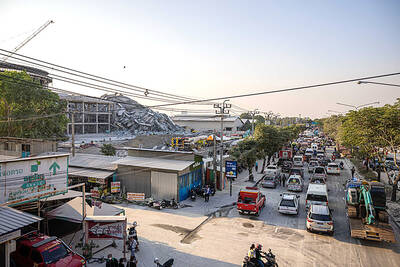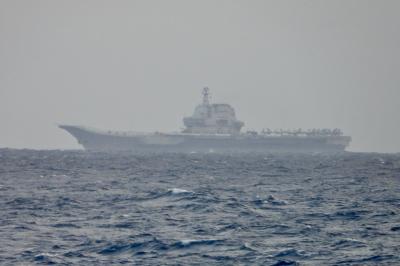Rich oil reserves locked in rock formations outside Paris are about to be tapped in a new French-American venture that highlights Europe’s quest for new, diverse energy sources.
In a first for France, two companies have teamed up to produce shale oil from the Paris basin through a difficult and costly extraction process that involves blasting the rock with water and chemicals.
Toreador Resources and Hess, the leading producer of shale oil in the US, signed a deal last week for six wells, with the first one planned for later this year.
It marks the first time that France has opted for this form of unconventional oil exploration and the project will be submitted to President Nicolas Sarkozy’s government for approval.
“We know that the oil is there. The question is whether we will be successful in producing it,” Toreador vice president Julien Balkany said.
His company estimates potential reserves in the Paris basin at 65 billion barrels, but only a tiny portion of that can be extracted — between 0.5 and 1 percent.
Hess paid US$15 million to become co-holder of Toreador’s exploration permits and will invest up to US$120 million over the next five years in the Paris basin project.
The company, headquartered in New York, is already pumping 13,000 barrels from the Bakken shale play in the US state of North Dakota, bordering Canada.
“The technology we use to produce oil in US unconventional plays will have a direct application to the Paris basin,” said Greg Hill, president of exploration and production at Hess.
Contrary to conventional exploration, shale oil requires horizontal wells to crack open the rock over 4km or 5km at depths of 2,000m to 3,000m.
France has up to now shied away from such unconventional exploration, mainly because of the cost, but with oil prices rising again to well above US$70, the temptation to drill is strong.
“With [current prices] ... the viability of the project is guaranteed,” said Charles Lamiraux, head of oil exploration at the French energy ministry.
A first well will be drilled this year, with three possible areas — Chateau-Thierry, Leudon-en-Brie or Nogent-sur-Seine, all located a few dozen kilometers away from Paris.
While the world’s biggest oil shale deposits are in the US, Russia leads the list of producers in Europe and deposits have been found in a dozen countries.
There has been a recent push in Europe to tap into shale gas as European governments grow anxious over their increasing energy dependence on Russia.
France, which relies heavily on nuclear power to meet its energy needs, could cover 5 percent of its oil requirements through the new energy source, Lamiraux said.
It currently only produces 1 percent of its oil consumption needs, through production in the Paris basin and the Aquitaine basin in the southwest.
More than 800 exploration wells have already been drilled in the Paris basin, but oil production has dropped from 40,000 barrels per day in the 1980s to its current level of 10,000 barrels per day.

US President Donald Trump yesterday announced sweeping "reciprocal tariffs" on US trading partners, including a 32 percent tax on goods from Taiwan that is set to take effect on Wednesday. At a Rose Garden event, Trump declared a 10 percent baseline tax on imports from all countries, with the White House saying it would take effect on Saturday. Countries with larger trade surpluses with the US would face higher duties beginning on Wednesday, including Taiwan (32 percent), China (34 percent), Japan (24 percent), South Korea (25 percent), Vietnam (46 percent) and Thailand (36 percent). Canada and Mexico, the two largest US trading

AIR SUPPORT: The Ministry of National Defense thanked the US for the delivery, adding that it was an indicator of the White House’s commitment to the Taiwan Relations Act Deputy Minister of National Defense Po Horng-huei (柏鴻輝) and Representative to the US Alexander Yui on Friday attended a delivery ceremony for the first of Taiwan’s long-awaited 66 F-16C/D Block 70 jets at a Lockheed Martin Corp factory in Greenville, South Carolina. “We are so proud to be the global home of the F-16 and to support Taiwan’s air defense capabilities,” US Representative William Timmons wrote on X, alongside a photograph of Taiwanese and US officials at the event. The F-16C/D Block 70 jets Taiwan ordered have the same capabilities as aircraft that had been upgraded to F-16Vs. The batch of Lockheed Martin

GRIDLOCK: The National Fire Agency’s Special Search and Rescue team is on standby to travel to the countries to help out with the rescue effort A powerful earthquake rocked Myanmar and neighboring Thailand yesterday, killing at least three people in Bangkok and burying dozens when a high-rise building under construction collapsed. Footage shared on social media from Myanmar’s second-largest city showed widespread destruction, raising fears that many were trapped under the rubble or killed. The magnitude 7.7 earthquake, with an epicenter near Mandalay in Myanmar, struck at midday and was followed by a strong magnitude 6.4 aftershock. The extent of death, injury and destruction — especially in Myanmar, which is embroiled in a civil war and where information is tightly controlled at the best of times —

China's military today said it began joint army, navy and rocket force exercises around Taiwan to "serve as a stern warning and powerful deterrent against Taiwanese independence," calling President William Lai (賴清德) a "parasite." The exercises come after Lai called Beijing a "foreign hostile force" last month. More than 10 Chinese military ships approached close to Taiwan's 24 nautical mile (44.4km) contiguous zone this morning and Taiwan sent its own warships to respond, two senior Taiwanese officials said. Taiwan has not yet detected any live fire by the Chinese military so far, one of the officials said. The drills took place after US Secretary